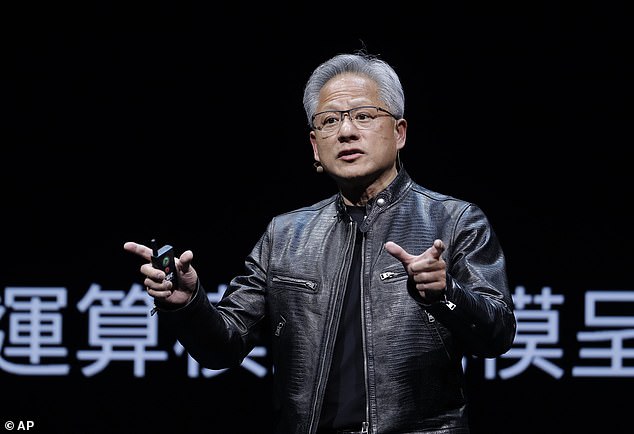It is the stock market success story of the century and one that will mark the rest of our lives.
Since going public on the eve of the Millennium, computer chip designer Nvidia has emerged from nowhere to become the world’s largest company.
The notable milestone was passed yesterday as its share price soared to a new high, overtaking tech giant Microsoft to value the Silicon Valley pioneer at $3.34bn (£2.6bn).
To put this in context, Nvidia’s stock market valuation now exceeds the annual output of the entire British economy.
It has been a truly stratospheric rise.
In February, Nvidia became the fastest company to go from $1 trillion to $2 trillion. Surprisingly, it only took eight months.
Jensen Huang, 61, a Taiwanese-born electrical engineering graduate who founded Nvidia along with microchip designers Chris Malachowsky and Curtis Priem.

Nvidia originally made computer chips for video game software, but has since expanded its horizons to dominate the artificial intelligence sector.
The latest rise means that the company, whose chips have fueled the meteoric rise of artificial intelligence (AI), has seen its share price rise from less than $4 in June 2019 to almost $136 today. That’s an incredible 3,477 percent increase in five years.
So how did a startup with no business plan, founded in a California restaurant, conquer everything before it? And will British private investors be able to get a piece of the action?
Nvidia is the brainchild of Jensen Huang – a Taiwanese-born electrical engineering graduate whose parents sent him to the United States as a child – and two microchip designers, Chris Malachowsky and Curtis Priem.
They founded Nvidia in 1993 in a Denny’s restaurant in San Jose, in the heart of Silicon Valley.
The plan was to call their company NVision, until they discovered that that name had been adopted by a toilet paper manufacturer. Huang, who once worked as a waiter and dishwasher at a Denny’s for $2.65 an hour, suggested Nvidia, based on the Latin word “invidia,” which means “envy.”
He has run the company ever since, becoming one of the richest people in the world in the process.
Nvidia’s main product is a graphics processing unit (GPU), a wafer-thin circuit board with a powerful microchip at its core. These processors allow lightweight, energy-efficient personal computers and laptops to perform a large number of calculations at high speed.
For decades the big microchip manufacturer was Intel, but Nvidia differs from its rival in some key aspects.
Intel and others make industry-standard general-purpose chips known as “central processing units” (CPUs), which handle all of a computer’s main functions, producing one mathematical calculation at a time.
But Nvidia’s GPU can complete complex, repetitive tasks much faster, breaking them down into smaller components before processing them in parallel.
If CPUs are delivery vehicles that deliver one package at a time, Nvidia’s GPUs are more like a fleet of high-speed motorcycles spread across a city. That made them the perfect processors to power the nascent AI revolution.
Unlike Intel, Nvidia does not manufacture its own chips, but primarily outsources them to Taiwan Semiconductor Manufacturing Company. Most importantly, however, Nvidia not only designs the hardware, but also the software it runs on.
“What Nvidia does for a living is not building the chip: we build the entire supercomputer, from the chip to the system, the interconnects, the NVLink, the networks, but very importantly, the software,” says Huang, 61 .
This secret software package is called Cuda. Nvidia chips were originally intended to improve computer graphics used by video games. The creation of Cuda in 2006 allowed other multi-purpose applications to also run on Nvidia chips.
At first, AI was not one of them. In the early 2010s, AI was still a technological backwater where progress in areas such as speech and image recognition was slow.
Even less fashionable were “neural networks,” computing structures that mimic the functioning of the human brain.
Nvidia’s breakthrough came when the Cuda platform was championed by British-Canadian computer scientist and cognitive psychologist Geoffrey Hinton, dubbed the “godfather of AI.”
Two of his students trained a neural network to identify cat videos using just two Nvidia boards. Google experts needed 16,000 CPUs to accomplish the feat. Machine learning had arrived.
The surprising results led Huang to bet on AI in 2013.
Nvidia GPUs were soon found in everything from smart cars to robotics to data centers, with customers ranging from Tesla to Microsoft and Amazon. One setback was a failed £31bn bid to buy Cambridge-based chip designer Arm Holdings.
But Nvidia really came of age a year ago with the news that ChatGPT (Open AI’s chatbot) was working with its supercomputers. This propelled the stock into orbit.
The news sparked a frenzy among big tech companies and AI startups for Nvidia processors, leading to a shortage that could last into next year.
On May 23, extraordinary results that exceeded market expectations caused the company’s value to increase by $200 billion in just one day.
To meet the insatiable demand, Nvidia plans to launch a new generation of artificial intelligence chips (codenamed Blackwell) later this year, costing more than $30,000 each.
It can charge so much because of its stranglehold on the AI chip market, with a market share of more than 80 percent.
This quasi-monopoly has turned Nvidia into a huge money-making machine, driving potentially huge future increases in stock price.
Some links in this article may be affiliate links. If you click on them, we may earn a small commission. That helps us fund This Is Money and keep it free to use. We do not write articles to promote products. We do not allow any commercial relationship to affect our editorial independence.

